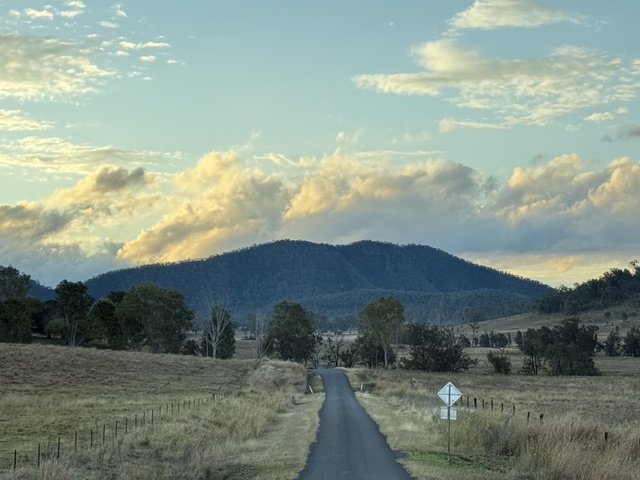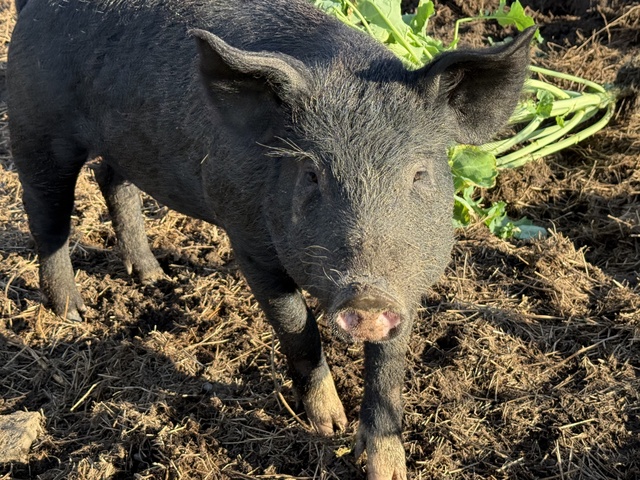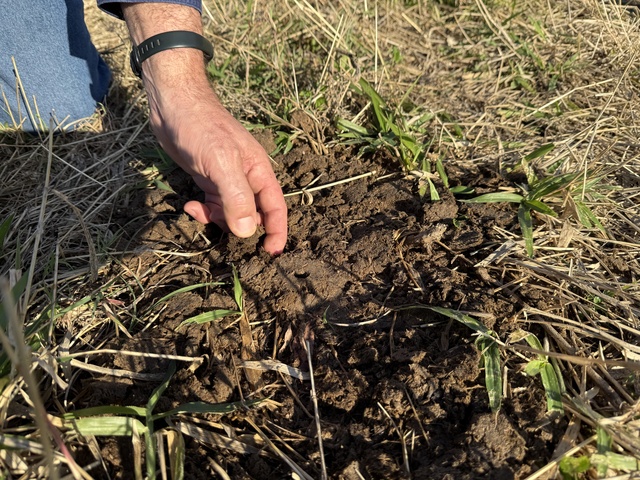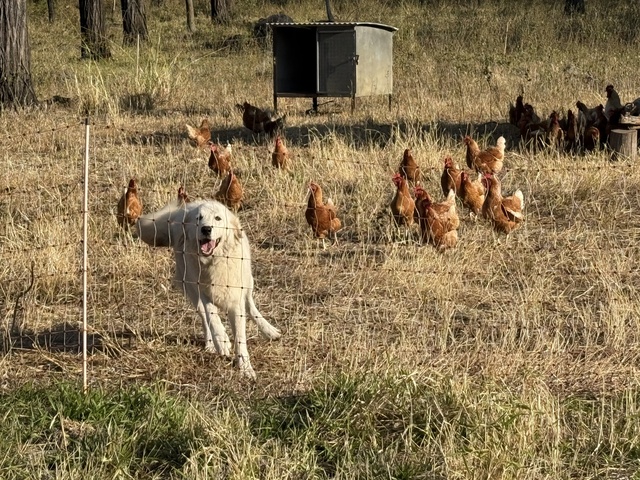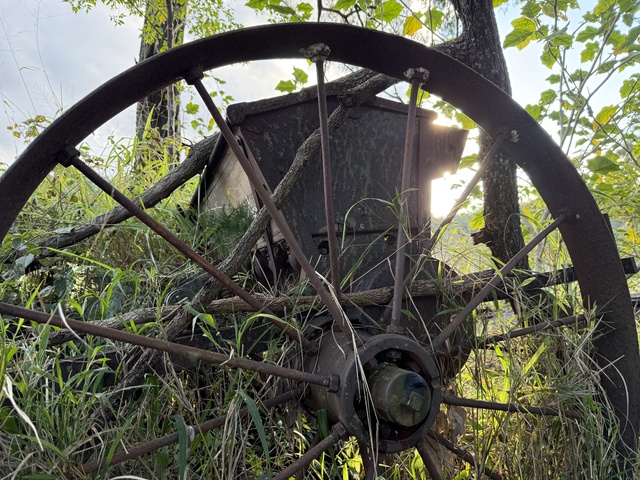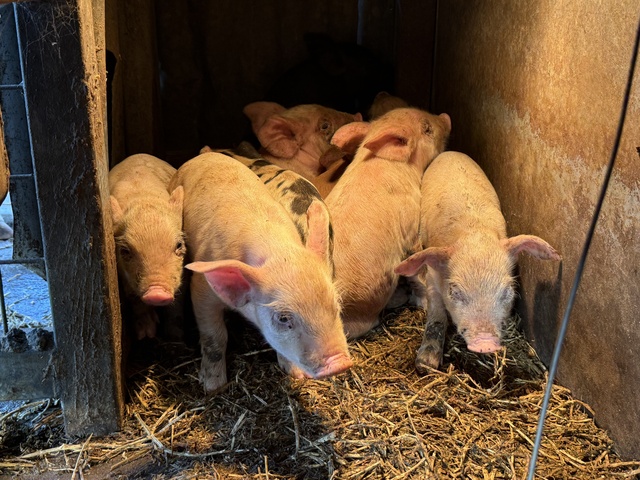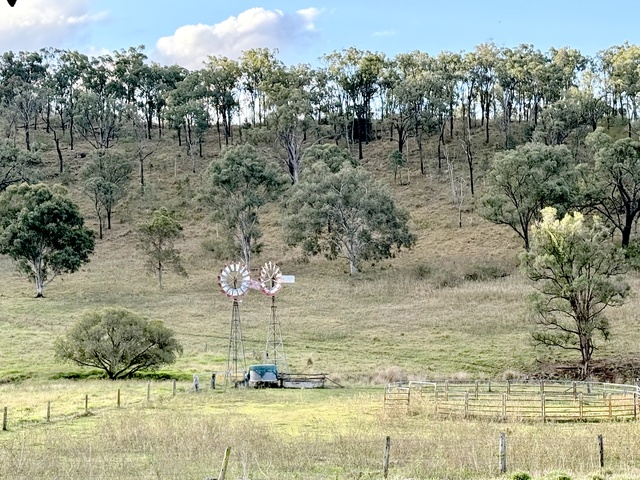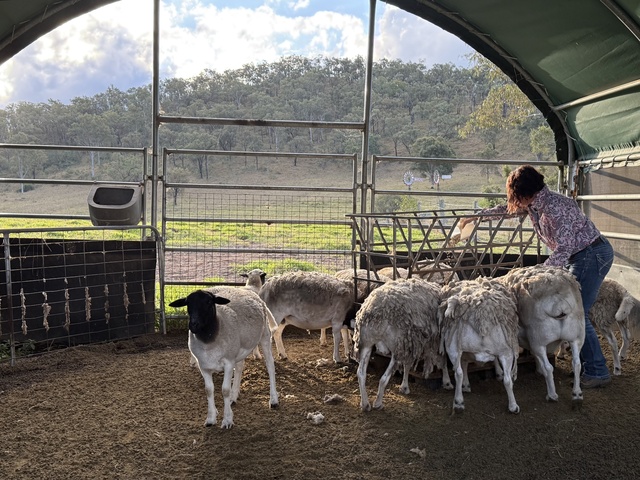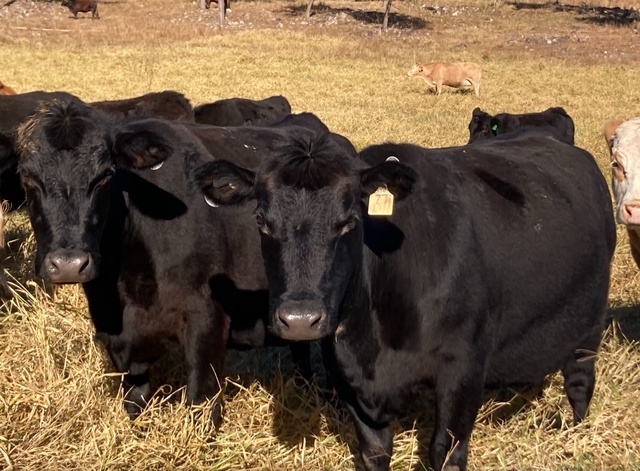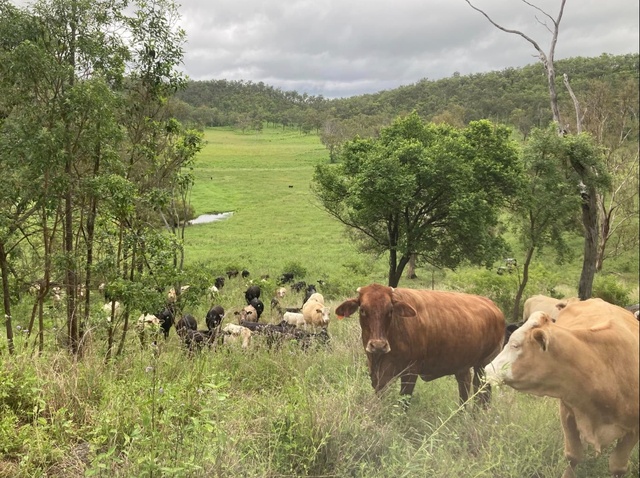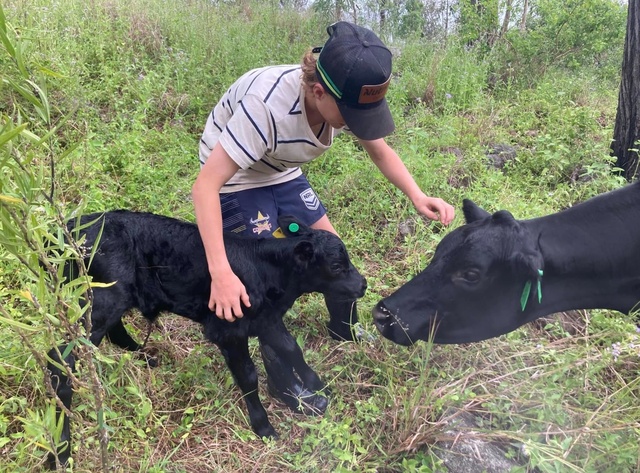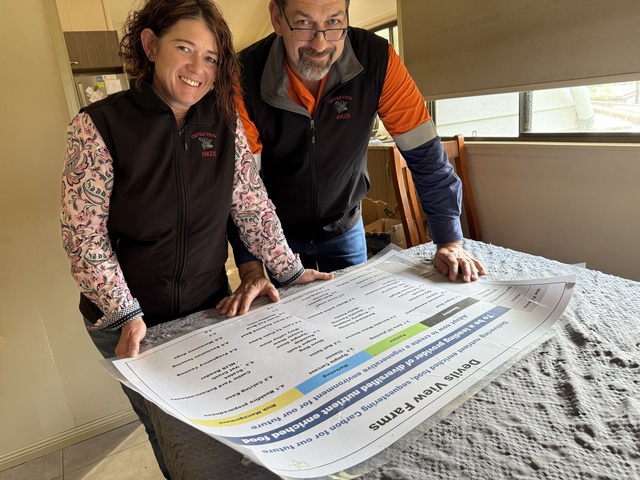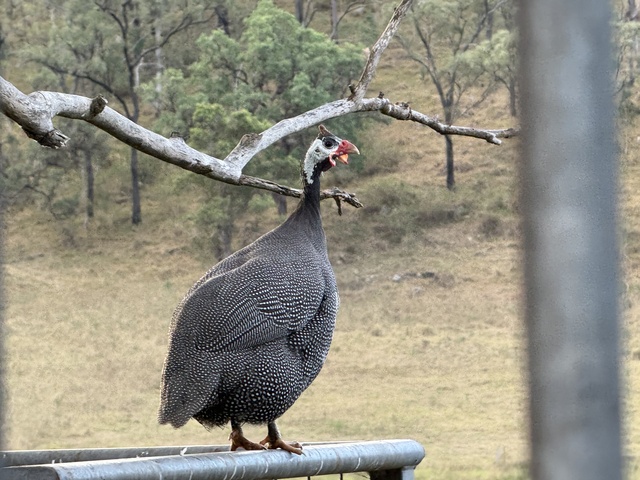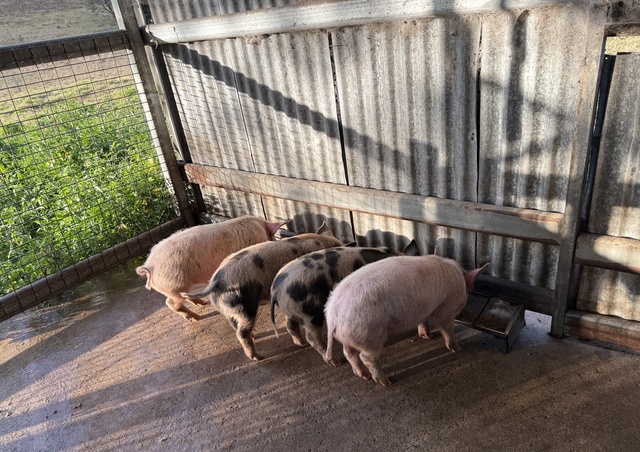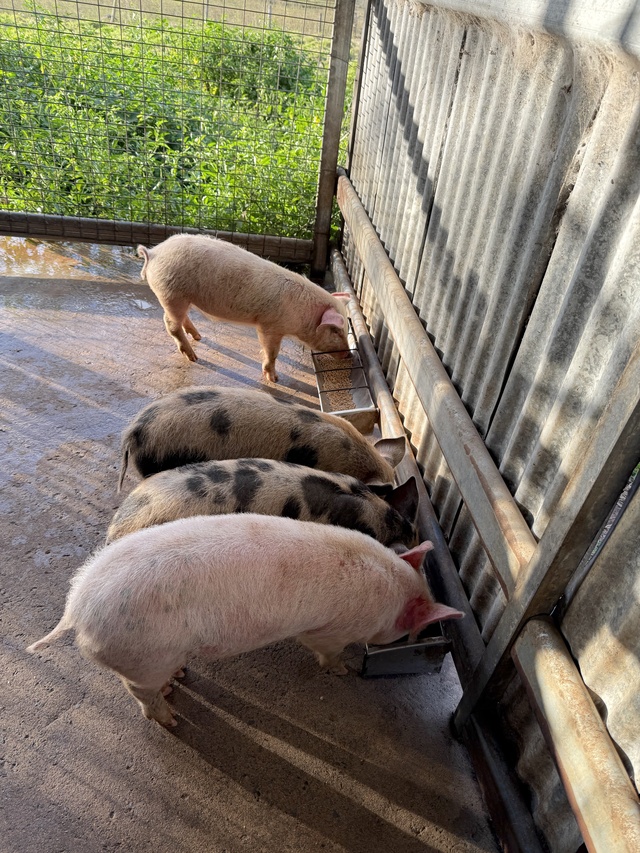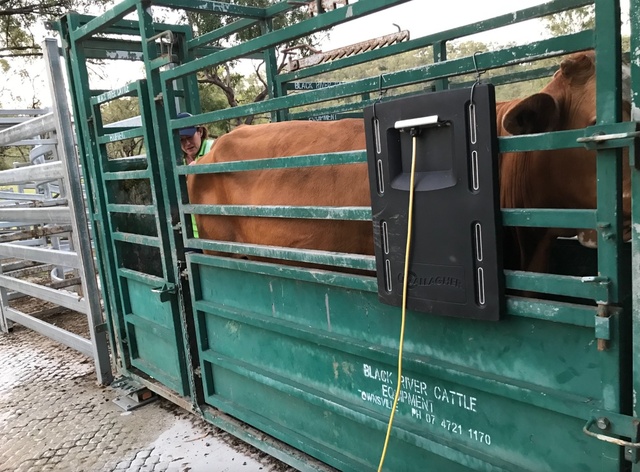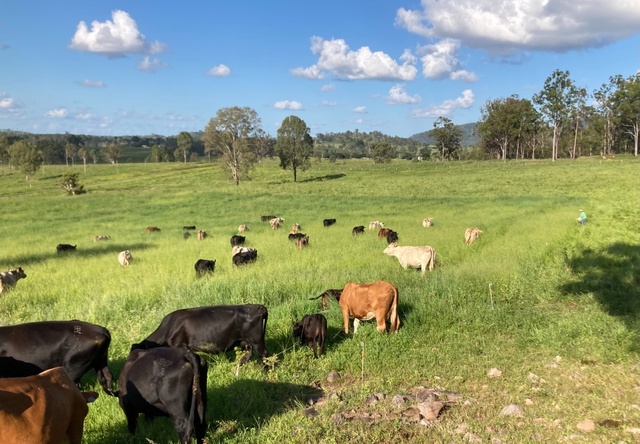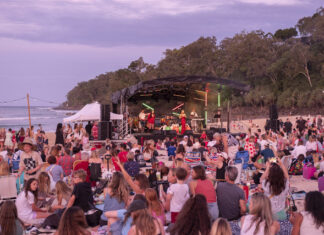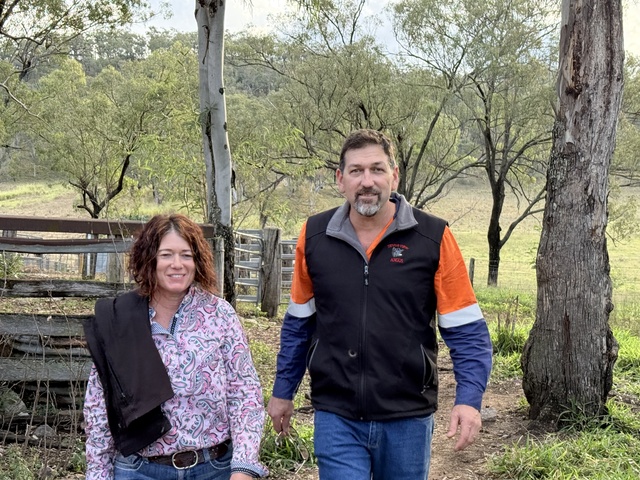
Farming the land is not for the faint-hearted – floods, fire and drought are some of the challenges faced. Yet as ERLE LEVEY finds, lessons learned over time time and from being prepared to change can bring a whole new future.
“If we think we’re not going to get burnt out again then we’ve got to change. We’ve got to be the agent of change and do something different.’’
There are times when things happen outside your control that can seem like a disaster … but they have the ability to change your life and your focus.
That’s what happened with Bradley Pike and his family of Devil’s View Angus at Woolooga.
When fire came through Woolooga in 2018 it almost completely burned out their grazing property.
Yet from that, the family decided to switch to regenerative farming, concentrate completely on Angus cattle and do their own paddock-to-plate deliveries of the produce.
That is to provide a four-point plan to ensure quality of their produce – from how the cattle are raised, the most stress-free time at the abattoir, the desired cuts of meat, and finally the delivery of the finished product.
That’s just part of their story … one that started in the 1880s and has seen many changes in the way the land has been utilised.
Their journey is one of drought, fire and now regenerative farming methods.
The definition of insanity is to keep doing the same thing and expect change, Brad told me at their property – one that has been part of the Pike family at Woolooga for at least four generations.
The changes that Brad and Ann-Maree have put in place in the past five years have meant new attitudes – but in many ways those attitudes revert back to original farming techniques as used by the Pike family when they first settled in the area.
The use of windmills to pump water, the gradual change to solar pumps – again a renewable energy source. There’s even been some successful water divining in those early days.
Driving onto the property along a north-facing gully with rolling ridgelands on either side, you notice the quality of the grasslands, the windmills, solar pumps and movable fencing.
Good tree cover has been retained on the ridges in particular to provide shade for the livestock, and attract as well as retain moisture.
Sitting in the kitchen of the farmhouse, Brad and Ann-Maree admit it is very much a family affair – not just from the past generations but with their children being involved in different aspects.
Brad grew up in the area and went to school in Gympie before going north to work with his father at Stanwell Power Plant.
He has worked as a rigger at power plants throughout Queensland but in 2013 took over the Devils View farm – one of four Pike holdings in Woolooga.
Ann-Maree grew up on a small farm in the Tiaro area and later worked in Gympie before they met. That was at a New Year’s Eve dance at Woolooga.
The Devils View Angus brand comes from the nearby Devils Mountain. At 444m above sea level, it is the highpoint of the area and forms part of the Great Dividing Range.
As well as cattle, the family raise some pigs, sheep and chickens. Oh, and there are one or two horses.
The livestock helps to re-energise the soil with hay bales placed on higher parts of the property. These will absorb five times the amount of water the land will and it just filters into the soil rather than running straight off.
The livestock feeding on the hay means manure is trodden into the soil, along with grass seed.
As well as reviving these areas, the nutrients make their way downhill to syntropic and permaculture gardens.
“What we love most about our style of farming is the provenance of our food,’’ Brad said. “Knowing where it comes from and how we can give a guide to authenticity or quality.
“We are creating healthy soils and at the same time allowing our animals to express themselves.
“With natural sequence farming you look at your high points and ridges then you put your chickens and your animals up there to get a lot of nutrient and that then flows down.
“You bring your forage from the low areas and it cascades down. That’s how you build soil.’’
As you come up the driveway there is a big, old blue gum tree that has had branches chopped off over the years.
“That was a rifle range,’’ Brad said, underlining the family history in the area. “My grandfather was a master rifleman, and it was 800 hundred yards or 1000 yards.’’
That’s when he showed me a newspaper cutting from 1901: “Should there be any man in this state doubting the advantages of mixed farming and co-operation, I would advise him to pay a visit to Acacia Vale, the property of Messrs Pike Brothers at Brooyar on the Kilkivan line.
“The Pike family came from Devonshire into Queensland some 12 or 18 years ago with small capital but plenty of savee, go and pluck.
“They were on their way to New Zealand but were so pleased with Queensland that they broke their journey here and resolved to throw in their lot with us.
“They soon selected a piece of excellent and well-watered land on the resumed part of Widgee run.’’
The original Pike family holding Acacia Vale was 4000 acres – 1000 acres at Devils View Angus, 1000 on Pike Rd and 2000 at Staib Rd.
The homestead was at Pike Road and there are two graves that bear testament to that.
Through the generations the holding has been cut into four and farmed by successive family members.
“When I bought the place off Dad, I ripped the soil and planted my salad mix,’’ Brad said. “We would walk around with a little seed spinner.
“It was a pasture mix but I was growing my own fertiliser, with turnips and radishes and all that.
“At first it was just sown down the valley but then I would put bales of hay on the ridges and get the little salad mix in. That’s been helped by the cattle as they would eat the hay, tromp it in, and all this fresh grass would come up.’’
Brad and Ann-Maree run about 90 breeders and their plan is to have about 120.
They have been on the farm since 2013 and were mainly grazing Charolais, a few Simmental and Angus.
There are still a few Simmental commercial cows but the bushfire was the turning point for moving to Angus.
“If we think we’re not going to get burnt out again then we’ve got to change,’’ Brad said.
“We’ve got to be the agent of change and do something different.
“We met another farmer from Mooloo who was running 360 head of cattle on 300 acres … young cattle between 250 kg to 400 kg that are in the growth stage.
“We looked at his property he’s got all these pizza-shaped paddocks everywhere, with a central cattle trough and they come to that.
“It looked expensive … and thought we couldn’t afford that. Yet it also looked awesome.’’
There’s a lot of money invested in concrete troughs and fencing but it was only one or two electric wires that were movable.
A chat with another farmer near Murgon showed he had 400m between permanent fencing, and then a moveable electric wire to shift the cattle to fresh pasture.
“Whereas he had flat country, with no trees and no gullies, we wondered how we were going to do that here.
“He just had a poly (electric fence) winder with the tread-in posts. By moving it a few metres he would bend the fence around trees or rocks and strip graze.
“I guess the moral of the story is, again it’s growth mindset, you have got to understand what’s available, what other people are doing, then bring it home and say: ’Well, what can we do? What can’t we do?’’
As Brad was working away on power stations, he would come home at weekends to get the fencing ahead ready for strip grazing the cattle.
They had to be moved to another strip every day.
At the same time he was building infrastructure – the wires and cabling, troughs to water the cattle in the weeks ahead.
It was up to Ann-Maree to change the fences so the cattle would move into the next section.
As part of the preparation they realised Ann-Maree and young son Regan couldn’t push the posts into the ground.
They were tread-in posts and that showed how hard the ground was in those early days.
“I had to sit on the ground and hammer the steps on the posts in,’’ Ann-Maree said.
“It took about 18 months to see the change in the soil from the regen. It was about the time of Covid and we could just push the posts in.
“So we were starting to retain moisture in the ground already from our planting and the cattle.’’
That was a great indication of the nutrients being brought back into the soil.
The rain was not running off the paddocks. Instead it was sucking into the ground and then it travelling under the ground to the gullies.
“We don’t have a creek through our place at the moment,’’ Brad said, “but the dams are constantly overflowing.
“There hasn’t been a dry dam in five to six years.’’
Another indication of the nutrients in the soil is the proliferation of dung beetles.
They generally burrow and store the animal manure in the ground, and as we walked through the paddocks we could see their presence.
Manure less than 24 hours old was just bubbling with the activity of the beetles.
By utilising windmills Brad is continuing to follow his grandfather and father’s love, and being a rigger it is no problem to work on them.
“I can maintain them myself – fix them, service them. I can climb up and put a harness on.
“They are pumping to the troughs – up to concrete header tanks then gravity-fed everywhere.’’
Part of the planning is to create contours and make some half-moon swailes to slow and spread the water on the land.
As well as the cattle, Brad and Ann-Maree have dorper sheep – mainly for home use.
However, the pigs are more than enough for the family. The breeds include a Berkshire-cross female and a large white male, with Landrace one they prefer.
The aim is to have pasture-raised pigs that can wallow in their own ’pigginess.’
As for the strip fencing for cattle, it not only stops over-grazing and compaction of the soil but helps break the parasite breeding cycle.
Naturally fireproofing of the property has been important, with fire breaks created and water pumps organised.
“On that day,’’ Ann-Maree said, “no fire breaks were ever going to stop that fire.
“It was the middle of September and we had that much dry feed.
“The speed with which it came from the grid at the front of the property and cut across to the house … I could hear it coming. The flames were six-foot tall coming up the driveway.
“It was pretty scary. I don’t want to see it again.’’
From that time, they set out to deliver nutrition-rich food and sequester carbon for a future.
It was imperative to adapt now to create a regenerative environment for the future, Brad said.
The business plan for Devils View Angus was set in 2022 around genetics, pasture, marketing and risk management.
They decided on one breed – Angus – because of expected beef value, growth, calving ease and carcass weight.
“We kicked off an artificial insemination program,’’ Brad said. “With our bull sales we’ve got a progeny buy-back so we can get some security with the quality of the product.
“It’s a matter of authenticity. We can show where they come from as we want to close the loop.’’
In this way they are ensuring the quality doesn’t drop. It has also been about exploring markets in regard to grass-fed as well as grass-finished beef.
The Devils View Angus process started due to farm insurance after the bushfire.
They realised that so much of the rebuilding of fences and stock yards was up to themselves.
They did an inventory and put a value on the infrastructure.
Ann-Maree’s father used to work at an abattoir and he used to do farm beef with the butcher.
“We got our own place and started doing it with our own livestock – killed on farm and we would eat it on farm.
“Then friends would ask if they could take a quarter of the animal.
“That’s when we got this idea. We couldn’t do it ourselves but we got the idea.
“We’ll get the animal to the abattoir – but you have got to pick it up from the butcher.
“That was based around when we needed meat. Then came the idea of the meat pack – one-eighth packs and we would retain one.’’
Brad would borrow or dry hire a cold room and then deliver all the beef.
It got to be monthly and finally they bought their own cold room in order to get set up properly.
Now they have devised separate product packs for customers looking for different cuts of meat.
Creation of the Devils View Angus brand company gives separation from the farm.
The next move is to develop an on-farm abattoir that should be up and running by this time next year.
It’s a big step but the planning is well under way.
“So far we have instigated zero-till planting,’’ Brad said. “I’ve got a reliable water source but will put some more bores down.
“The property mapping to design electric fencing and water points has enabled rotational grazing – we have winter-active pasture.
“I’ve still got a bit of work to do but the main thing is we have started.’’
A major asset of their cattle is the genetics, their temperament and inter-muscular fat.
“The genetics … that’s what gives us that edge,’’ Brad said. “The animals are so quiet and treated with respect.’’
While the fire was a turning point, the mapping of the property and understanding of the land was a major step forward.
What drives Brad and Ann-Maree is their four-point accountability checklist.
They have learned from experience that cuts of beef can be incorrect – the wrong thickness or way it is cut.
“We didn’t want to be trying to explain to customers that it was outside of our control,’’ Ann-Maree said.
“You want to have that control.’’
As Brad said: “We are accountable and we want to get that accountability back in house.
“If we are breeding the animals then processing, we’ve got to think about the end user … how do they want to portion the steaks, do they want them thick or thin?
“They need to know we can be relied on to deliver what they want … not a standardisation.’’
In short, Brad and Ann-Maree want to be accountable for the quality of the product, the quality of the processing of that product, and the quality of the delivery.
“We are thinking of the animal to start off with,’’ Ann-Maree said. “Total respect.’’
Deliveries go to customers from Hervey Bay to the Sunshine Coast, either as a home delivery or from arranged pick-up points.
There are different distribution models that depend on where customers are … it could be interstate as well.
Driving along Pike Road with the sun setting behind Devils Mountain I could not help but be impressed by the resilience of farmers.
The way they can overcome challenges – not only through a positive outlook but by their inventiveness and ability to forge new pathways.
These cannot only be fresh initiatives but by understanding and leaning into the old ways and what the land is telling them.
This comes from a belief, intuition and learned skills. Overcoming a problem is in fact an investment in the future as farmers, like all of us, are guardians of this land on which we live.


